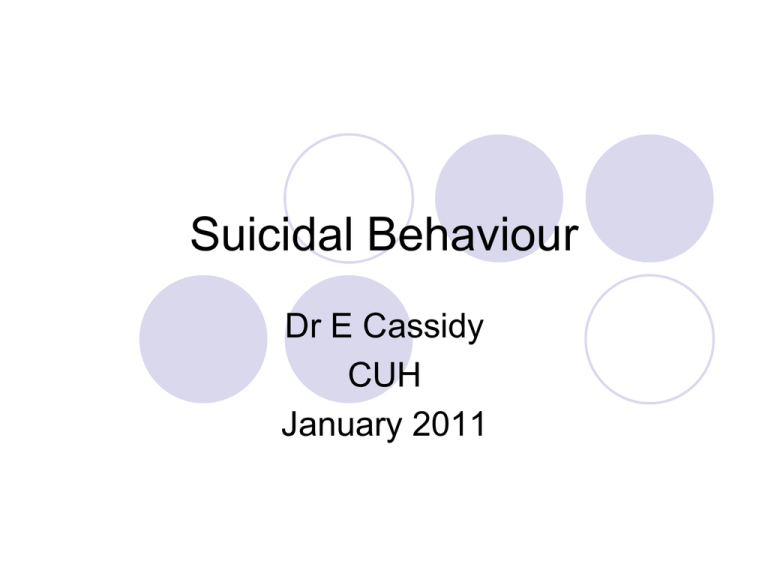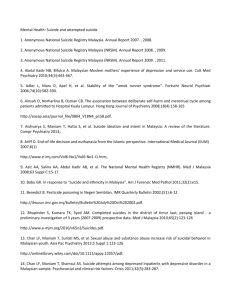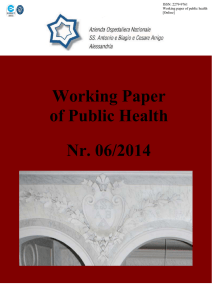Suicide and Self-Harm Lecture to Medical Students December 2011
advertisement

Suicidal Behaviour Dr E Cassidy CUH January 2011 Terminology Suicide Death by individual who died “intentional” act or omission “completed” rather than “successful” Self-Harm Attempted Suicide Deliberate Self-Harm Parasuicide Self-Poisoning or Self-Injury Self-Mutilitation Everything that doesn’t involve death – a behaviour not a diagnosis Suicide Deaths classified as suicide in Ireland (1996-2009) 500 Men 450 Women Number of deaths 400 350 300 250 200 150 100 50 0 1996 1997 1998 1999 2000 2001 2002 2003 2004 2005 2006 2007 2008 2009 Year 2008 and 2009 figures are provisional Trends in undetermined deaths in Ireland (1996-2009) 160 Men Number of deaths 140 Women 120 100 80 60 40 20 0 1996 1997 1998 1999 2000 2001 2002 2003 2004 2005 2006 2007 2008 2009 Year 2008 and 2009 figures are provisional SUICIDE IN IRELAND •500 per year •Peak M 20-24yo (34/100,000) •Peak F 45-54yo •Males @ 80% •Hanging, Poisoning, Drowning Associations Unemployed and retired Divorced, never married Certain Professions Social class: I and V Country variation lower in LDCs than Western; China (females) Cultural variation Seasonal variation Highest April to June Context 1 in 6 leave notes 1 in 2 have self harmed in the past Majority have told someone GP in previous month Suicide and Psychiatry ?90% suffer from some mental disorder OCD may protect Suicide and Schizophrenia 10% mortality Risks with Early in illness Males, younger Relapses Akathisia Recent discharge Paranoid ( Roy, 1982 ) Suicide and Depression 5-15% lifetime risk Melancholic depression Psychotic depression Family History Self-Harm Incidence of deliberate self harm 2003-2009 Total number of DSH episodes: 75,119 Total number of individuals involved: 48,206 Year Male rate* % diff Female rate* % diff 2003 179 2004 170 -5% 229 -5% 2005 165 -3% 227 -1% 2006 160 -3% 210 -8% 2007 162 +2% 216 +3% 2008 179 +10% 221 +2% 2009 197 +10% 221 +0.4% 241 85yrs+ 80-84yrs 75-79yrs 70-74yrs 600 65-69yrs 60-64yrs 55-59yrs 50-54yrs 45-49yrs 40-44yrs 35-39yrs 30-34yrs 25-29yrs 20-24yrs 15-19yrs 10-14yrs Rate per 100,000 Incidence of DSH by age and gender, Average rates 2003-2009 700 Male Female 500 400 300 200 100 0 Main method of self harm (Average 2003-2009) Men Women Alcohol 2% 4% 17% 25% 60% 3% Overdose Poisoning 2% 2% 1% 0% Hanging 76% 6% 2% 1% Drowning Cutting Other Alcohol was involved in 46% and 38% of male and female acts, respectively Intentions Most neither want nor expect to die 1/3 no thoughts Cry for help Escape Often impulsive 20-40% alcohol on board Recent life stress 20% repeats Self-Mutilation Punishment, Relieve tension Associations Separated and divorced Low Socioeconomic status Urban > Rural Childhood disadvantage Lack of Social Support Lack of Religious affiliation Collective (Princess Di effect, clustering) Availability of means (paracetamol) Cumulative probability of repeated DSH by DSH method and number of previous episodes Ka pla n-Meie rf a ilurees t ima te s Ka pla n-Meie rf a ilurees t ima te s 0.70 0.70 0.60 0.60 0.50 0.50 0.40 0.40 0.30 0.30 0.20 0.20 0.10 0.10 0.00 0.00 0 3 6 9 Time to to DSH (months) Time DSH (months) Self-cutting & overdose Self-cutting only Other Attempted drowning Attempted hanging Drug overdose only 12 0 3 6 9 12 Time to DSH (months) Four previous DSH presentations Three previous DSH presentations Two previous DSH presentations One previous DSH presentation No previous DSH presentation The burden of repeated deliberate self harm Number of DSH acts in 2003-2009 Persons Presentations Number (%) Number (%) One 37690 (78.2%) 37690 (50.2%) Two 5874 (12.2%) 11748 (15.6%) Three 2023 (4.2%) 6069 (8.1%) Four 881 (1.8%) 3524 (4.7%) Five 496 (1.0%) 2480 (3.3%) Six 345 (0.7%) 2070 (2.8%) Seven 203 (0.4%) 1421 (1.9%) Eight 132 (0.3%) 1056 (1.4%) Nine 109 (0.2%) 981 (1.3%) 10 or more 453 (0.9%) 8080 (10.8%) Factors associated with repetition independent of previous repetition Women aged 35-44 years had the highest risk of repetition (+33%) Among women, those who engaged in self-cutting only (+57%) and those with self-cutting with drug overdose (+48%) had the highest risk of repetition Among men, those engaging in self-cutting in combination with drug overdose had the highest risk (+49%) Aetiology of Suicidal Behaviour Vulnerability – Stress Vulnerability Family history Impulsive/aggressive personality traits Childhood adversity/abuse Hopelessness Over generalised autobiographical recall Stress Life and esp interpersonal stress Physical illness Failed Inhibition Alcohol and Drugs Head Injury/ cognitive impairment Lack of Adaptive Coping social support, problem solving ability Maladaptive coping with alcohol, drugs (disinhibition) Neurobiology Serotonin: Low 5-HIAA in CSF Reduced frontal 5-HT2A receptor biding 5HT is involved in impulsivity 5-HTTLP predicts self-harm following life stress HPA axis Hyperactivity predicts self-harm / completion in depressives Cholesterol Low cholesterol predicts Prefrontal Cortex Failed response inhibition Repetition Risk of Repetition Think of risk as immediate and long term Characteristics of attempt Characteristics of person Underlying psychiatric or physical disorder Repetition and Suicide 15% repeat by 1 year 10%% suicide at long-term outome Lethal prior method Psychiatric disorder Older males Social isolation Repeated self-harm Avoiding discovery at time of self-harm Strong suicidal intent Substance misuse (especially in young people) Hopelessness Poor physical health Enquiring about suicide Asking about suicide Asking about it does NOT increase the risk It may decrease it! But do it sensitively Ask sensitively Many people… After what you’ve told me… How do you think things will turn out ? Do you ever wish you would never wake up ? Have you thought about ending it all ? What would you do ? Assess suicidal risk Current plans and intent Availability How far down the path have they gone Why not yet Current mental state Previous attempts Planning, precautions Dangerousness (real and perceived) What happened Supports and ability to access them Initial Management Treat mental disorder Address needs Alcohol Finance Relationships Give crisis contact details Prevention Complex public health initiatives ? Reduce alcohol Identify and treat more Depression Lithium in Bipolar disorder Clozapine in Schizophrenia DBT in Borderline PD NATIONAL CONFIDENTIAL INQUIRY INTO SUICIDE AND HOMICIDE BY PEOPLE WITH MENTAL ILLNESS England and Wales Annual report 2009 Patient Suicide 26% suicides had contact with mental health services in the 12 months prior Suicides less common following non-compliance/loss of contact with services 14% of all suicides are Psychiatric Inpatients 70% of these occurred off the ward Inpatient suicides falling Fallen by 1/3 (50% less hanging/strangulation) Belts, shoelaces, sheets, towels Removal of non-collapsible curtain rails 2002 Psychiatric diagnosis Affective disorder (534) Schizophrenia (198 - stable) Personality disorder 104 - (fallen) Alcohol Dependence (83 - fallen) Drug Dependence (24 - fallen) Other (176) Method Hanging, OD, Jumping Hanging, jumping increased Overdose, CO poisoning decreased Drowning, firearms and burning stable Reach Out National Suicide Strategy 2005-2014


